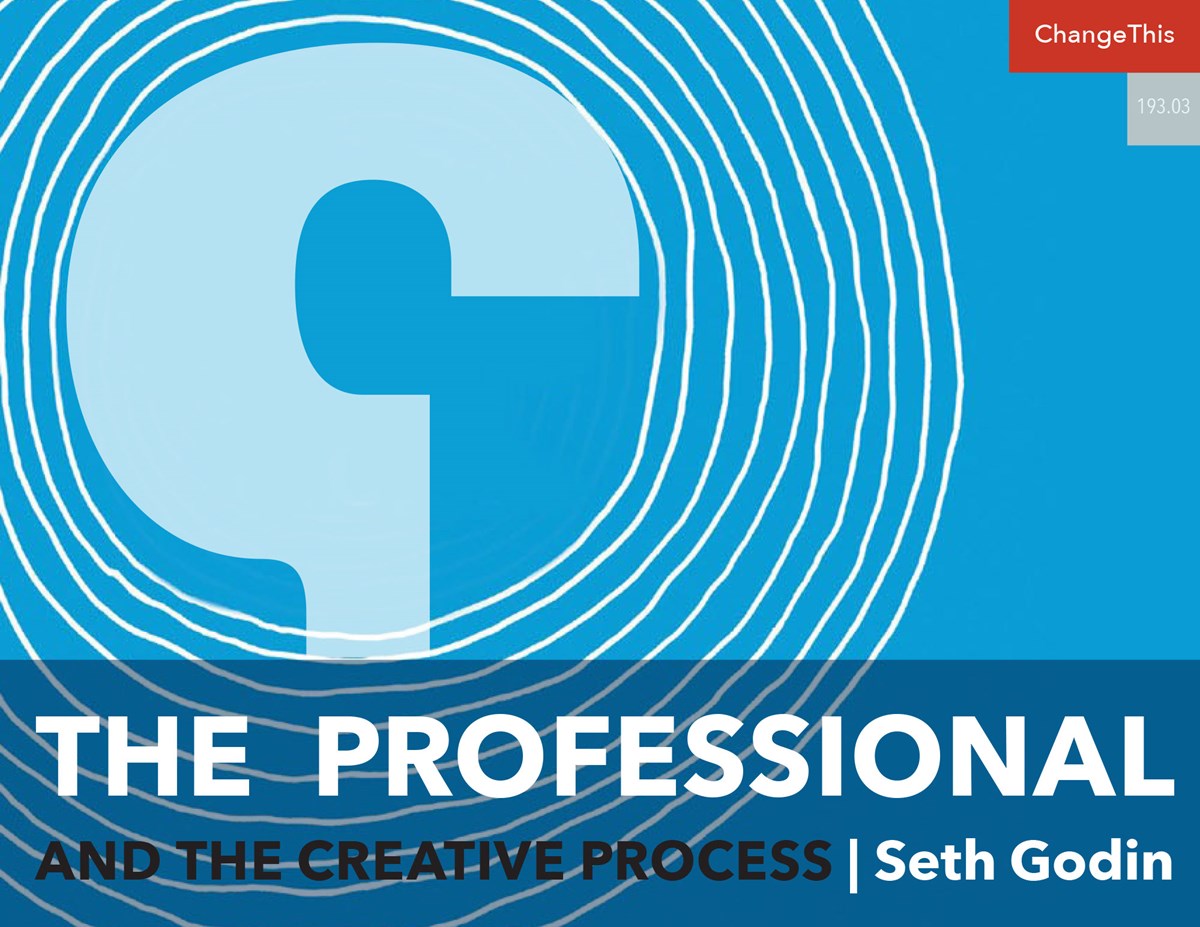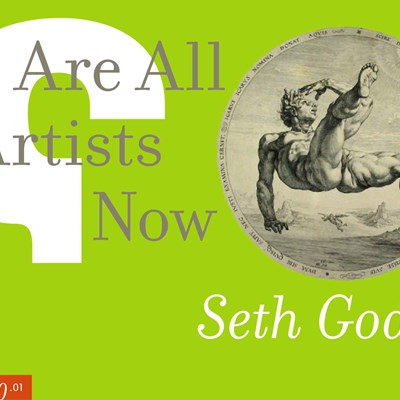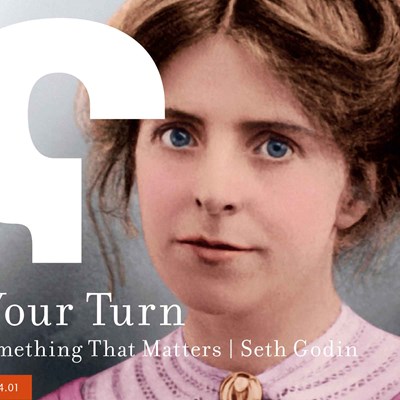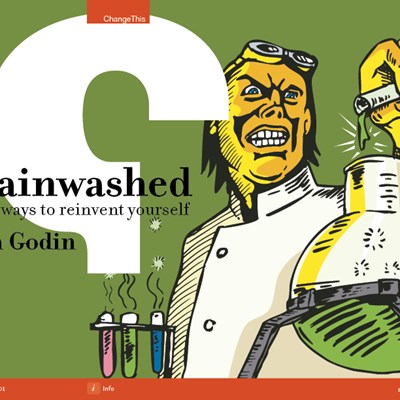The Professional and the Creative Process
October 28, 2020
We don’t ship the work because we’re creative. We’re creative because we ship the work.
The magic of the creative process is that there is no magic.
THE LIFEGUARD WHO WASN’T SURE
Sure, there had been the Water Safety Instructor test, and even the Bronze Medallion up in Canada, but this was still the first summer on the Michigan beach for most of the lifeguard crew. Each guard, deep down, knew that it wouldn’t be difficult to find a stronger swimmer and a braver soul.
Robin Kiefer was only six that day, but already a precocious swimmer. The water was warm, so Robin slipped away from a family gathering and started to play in the waves.
But when he started to flounder in the water and go down for the second time, there wasn’t any doubt about what to do. The lifeguard had learned her lessons well: uncertain or not, less qualified or not, you leap. Leap first, do your job.
Of course she wasn’t sure. How could she be?
The lifeguard didn’t jump in the water because she was a perfect swimmer or because she was certain that she was qualified to rescue this kid. She jumped in the water because it was her job. Because she was the closest available lifeguard. Because she had promised she would.
By the time Robin’s parents got to the beach, the lifeguard had already rescued him. They never got her name, but decades later, no one has forgotten what she did.
The irony runs pretty deep. Half a century before, Robin’s grandfather Adolph broke the world record in the backstroke, and the company that bears his name has sold more lifeguard buoys than any other company. And Robin is alive to tell the story because a lifeguard who wasn’t certain saved a kid who needed saving.
How can any of us be certain?
And yet, how can anyone who cares hold back?
YES, YOU’RE THE LIFEGUARD
Ethicist Peter Singer asks us to consider: if you were on your way to work, wearing brand-new beautiful leather shoes, and you passed a small child, face down in a stream, would you run into the shallow water and save her life?
Of course you would.
It doesn’t matter what happens to your shoes; it doesn’t matter who the kid is. You can do it and so you must do it.
And the same is true, if perhaps less dramatic, when it comes to your work.
Any idea withheld is an idea taken away. It’s selfish to hold back when there’s a chance you have something to offer.
WORRYING
If the problem can be solved, why worry? And if the problem can’t be solved, then worrying will do you no good. —Shantideva
Worrying is the quest for a guarantee, all so we can find the confidence to press on. It’s an endless search for a promise: the outcome will be worth the effort we put into the process.
Worrying is impossible without attachment. No one worries about the weather on Saturn, because no one is counting on the weather to be a certain way.
The time we spend worrying is actually time we’re spending trying to control something that is out of our control. Time invested in something that is within our control is called work. That’s where our most productive focus lies.
Worrying isn’t productive because it doesn’t produce confidence, and even if it did, the confidence wouldn’t last. Worrying is a way to hide from the fact that we are wavering on our practice.
Reassurance is futile. The reason is simple: we need an infinite amount of reassurance, delivered daily, to build up our confidence. There will never be enough. Instead of seeking reassurance and buttressing it with worry, we could make the choice to go back to work instead.
ON THE HOOK OR OFF
The traditional way to encourage people to contribute is to let them off the hook. Look for signs of genius. Point to the mysterious muse. Encourage people to sit quietly and let that other voice take over.
I have a hundred examples. Here’s one from Nobel winner Bob Dylan: “It’s like a ghost is writing a song like that. It gives you the song and it goes away, it goes away. You don’t know what it means. Except the ghost picked me to write the song.”[1] This is nonsense. There is no ghost. Dylan is either fooling us or fooling himself.
In the many conversations I’ve had with successful creatives, it sometimes gets a bit uncomfortable. Sometimes they wonder if looking directly at their source of inspiration will make it disappear.
The source is simple: It’s the self. It’s us when we get out of our way. It’s us when we put our self on the hook. No ghost. You. Us.
The industrial system has trained us to avoid the hook. Being on the hook means that you can get blamed, and getting blamed means you can get fired for what you did (or didn’t do).
For some of us, though, on the hook is the best place to be. It’s on you. It’s on me. Our choice, our turn, our responsibility. This is our practice.
The missing element, for so many, is our lack of trust. We feel that we somehow can’t trust ourselves enough to take this on, because it’s too fraught, too difficult, too risky …
Everything that matters is something we’ve chosen to do.
Everything that matters is a skill and an attitude.
Everything that matters is something we can learn.
The practice is choice plus skill plus attitude. We can learn it and we can do it again.
We don’t ship the work because we’re creative. We’re creative because we ship the work.
No ghost is needed.
TALENT IS NOT THE SAME AS SKILL
Who are you to make a change? How dare any of us stand up and announce that we’d like to make things better.
That sort of work is for other people. People who are talented. We’re told again and again that talent is a secret and rare resource that enables some to lead while others must be docile and accept what’s on offer.
But that’s confused.
Talent is something we’re born with: it’s in our DNA, a magical alignment of gifts.
But skill? Skill is earned. It’s learned and practiced and hard-won.
It’s insulting to call a professional talented. She’s skilled, first and foremost. Many people have talent, but only a few care enough to show up fully, to earn their skill. Skill is rarer than talent. Skill is earned. Skill is available to anyone who cares enough.
If you put the effort into your practice, you will be rewarded with better. Better taste, better judgment, and better capabilities.
In the words of Steve Martin: “I had no talent. None.”
WHERE IS YOUR HOUR?
If you want to get in shape, it’s not difficult. Spend an hour a day running or at the gym. Do that for six months or a year. Done.
That’s not the difficult part.
The difficult part is becoming the kind of person who goes to the gym every day.
And so it is with finding your voice. The tactics, the writing prompts, the kind of pencil—none of them matter compared to one simple thing: trusting yourself enough to be the kind of person who engages in the process of delivering creative work.
You manage to find an hour every day to bathe, to eat, to commute, to watch Netflix, to check your email, to hang out, to swipe at your phone, to read the news, to clean the kitchen …
Show us your hour spent on the practice and we’ll show you your creative path.
You already know what to do to be creative.
And you already know how to do it.
You’ve done it before, at least once.
At least once you’ve said or done something insightful, generous, and original. At least once you’ve solved a problem or given someone a hand by shining a light.
The practice simply asks you to do it more than once, to do it often enough that it becomes your practice.
BUT NOT A HACK
In London, there’s a borough called Hackney. Centuries ago, when the city was much less developed, Hackney was actually on the outskirts of town, a small village that specialized in raising horses.
Not racehorses or show horses. Regular horses. Cheap horses for cheap customers. Horses that were good enough to sell, but no better.
Those horses often got purchased to pull taxi carriages. And so the nickname for London cabbies was born: hacks.
Today, a hack isn’t something you want to be. A hack reverse-engineers all the work, barely getting by. The hack has no point of view, no assertions to be made. It’s simply “what do you need?” and “how little do I have to charge to get this gig?” (or “how much can I get away with?”).
It’s possible (and admirable, and even heroic) to be an amateur. The amateur serves only herself. If there are bystanders, that’s fine, but as an amateur your work is only for you. A privilege, a chance to find joy in creation.
And you may choose to make the leap to be a professional, to have a practice. To show up when the muse isn’t there, to show up if you don’t feel like it. This manifesto is for you.
But please, avoid the path of becoming a hack. Sure, work can be better than no work, but the posture of giving up your standards to get that work can quickly become toxic.
Once you see that you don’t need a lucky break and that the practice is available to anyone who is willing to commit, you may choose the life of a professional. Or you can embrace the path of the engaged amateur. But the choice is a fork in the road.
A professional is not simply a happy amateur who got paid.
IT’S NOT A PARADOX
But it’s not easy either.
Go too far to please the audience and you become a hack. Lose your point of view, lose your reason for doing the work, become a hack. Focus only on the results, become a hack.
On the other hand, if you ignore what you see and simply create for yourself, you’ve walked away from empathy. If there is no change, there is no art. The professional understands the fine line between showing up with a generous vision and showing up trying to control the outcome.
The best way through the paradox is by working.
Ship creative work. On a schedule. Without attachment and without reassurance.
193.03 WALKING AWAY FROM BEING A HACK
“Deliberately. . . . When she found out she was going over people’s heads, she went further, deliberately, the truth is she went right over people’s heads.” —David Crosby on Joni Mitchell
And that’s why we revere Joni Mitchell forty years later and barely remember what else was on the radio those days.
Artists don’t simply look in the rearview mirror, nor do they only play requests. While Mitchell was recording one of her live albums, the audience started calling out requests. She wondered aloud whether people ever asked Van Gogh to paint a Starry Night again.
“You have two options,” she told Rolling Stone, “You can stay the same and protect the formula that gave you your initial success. They’re going to crucify you for staying the same. If you change, they’re going to crucify you for changing. But staying the same is boring. And change is interesting. So of the two options,” she concluded cheerfully, “I’d rather be crucified for changing.”
Leaders make art and artists lead.
GENEROUS DOESN’T MEAN FREE
Too often, the market pushes creators to give away their work. And too often, we come to believe that giving it away, removing money from the interaction, is the most generous thing we can do.
But that’s not the case.
Money supports our commitment to the practice. Money permits us to turn professional, to focus our energy and our time on the work, creating more impact and more connection, not less.
And more importantly, money is how our society signifies enrollment. The person who has paid for your scarce time and scarce output is more likely to value it, to share it, and to take it seriously.
Generous doesn’t require us to reduce friction by making things free. It requires us to bring bravery and passion and empathy to the people we seek to serve. And that often requires tension on the part of the audience.
It’s tempting to hide by creating deniability. “What did you expect, it was free …” But often, the act of charging for the work creates a generous outcome, because our work is to effect change, not to make ourselves invisible and free.
IN SEARCH OF ENROLLMENT
In an economy based on connection instead of industry, most of what we seek isn’t actually scarce. People spend more than half their waking hours online now, in search of digital connection, entertainment, and access.
So what’s worth charging for? And what do people pay for?
If you’re leading, you’re searching for enrollment. For people who say “I see you and trust you and want to go where you are going.”
This is not what happens in compulsory education. People are there because they have to be, not because they want to be. They’re there for an education (and a certificate), not for learning or passion or magic.
When we are generous with our work, we have the chance to earn trust and attention, and if we’re fortunate, we will find the people who are ready to go on our journey. Those people will eagerly pay, because what we offer them is scarce and precious.
TOWARD IDIOSYNCRASY
The word “peculiar” comes from the idea of private property. Your cattle, to be specific. No one gets to control your livestock other than you. It’s private property.
No property is more private than your voice. Your dreams and fears and contributions are yours—peculiar to you, idiosyncratic.
The industrialized economy, which is now drawing to a close, was mostly about hiding your peculiarity. It was organized around cogs, replaceable parts, and the endless drive to fit in as much as possible.
If you had a voice, you were encouraged to lower it. If we wanted your opinion, we would have asked for it. If you wanted to make change, you should keep that desire to yourself.
We’ve just flipped this upside down.
Today, the best work and the best opportunities go to those who are hard to replace. The linchpins, the ones who are likely to be missed.
And, delightfully, at the very same time that the economy is rewarding idiosyncrasy, we’re discovering that it’s also the way we were meant to be.
Because being peculiar is natural. And being peculiar is beneficial.
All change comes from idiosyncratic voices. When you bring work from outside the status quo to people who need it, you’re doing something peculiar: specific, identifiable, and actionable.
CHOOSE YOUR CLIENTS, CHOOSE YOUR FUTURE
The masses aren’t the point. They might be a welcome side effect of your work, but to please the masses, you must pander to average.
Because mass means average.
When we decide that the change we seek to make is dependent on mass popularity, when we chase a hit, we end up sacrificing our point of view.
On average, every population is dull. The slide toward average sands off all the interesting edges, destroying energy, interest, and possibility.
What’s the difference between Chip Kidd, the extraordinarily successful book cover designer, and someone with the same tools and skills that Chip has?
Chip has better clients.
Better clients demand better work. Better clients want you to push the envelope, win awards, and challenge their expectations. Better clients pay on time. Better clients talk about you and your work.
But finding better clients isn’t easy, partly because we don’t trust ourselves enough to imagine that we deserve them.
Every gig-economy hustler who’s listed on Fiverr or Upwork or 99designs is looking for easy clients. Easy in and easy out, but they’re not better clients than they have now.
Years ago, I produced a record for a very skilled duo. They were incredibly hardworking and committed to their art. In order to survive, they performed three hundred days a year, and they lived in a van, driving each day to a new town, playing at a local coffeehouse, sleeping in the van, then repeating it all the next day.
In most towns, there are a few places like this—if you’ve issued a few CDs and are willing to work for cheap, you can get booked without too much trouble.
These cafés are not good clients. Easy in, easy out, next!
What I helped these musicians understand is that going from town to town and working with easy gigs was wasting their effort and hiding their art. What they needed to do was stay in one town, earn fans, play again, earn fans, move to a better venue, and do it again. And again.
Working their way up by claiming what they’d earned: fans.
WHERE ARE THE GREAT ARCHITECTS?
There are more than one hundred thousand licensed architects in the United States. Most of them signed up for the steady work of industrialized production. They were trained to build reliable, consistent, and efficient buildings.
Some, though, chose to see a different pattern for their work. They became architects to invent, to create, and to challenge the status quo. They are committed to building structures that invoke awe or wonder. If you’ve been in a building created by one of these architects, you’re likely to remember it.
What’s missing in this gap between good and great is the simple truth that you can’t be a great architect unless you have great clients.
And at the same time, great clients rarely seek out architects who desire to be only good.
When the client wants a cheap, easy building, the architect’s desire to do great work is rarely achieved. And when the client wants something important, she knows that hiring a merely good architect is a mistake.
It’s tempting to blame the clients. But the commitment to be a great architect also requires the professionalism to do the hard work of getting better clients.
THE MAGIC OF BETTER CLIENTS
Better clients are demanding. They demand more rigorous deadlines, but they also pay more. They demand extraordinary work, but they’re more respectful. And they demand work they can proudly share with others. Better clients also have good taste.
You know that better clients exist; you’ve seen them out in the world.
The trick is earning them.
You don’t do that by doing better work for lousy clients. That’s because lousy clients don’t want you to do better work. They are lousy clients for a reason. They don’t want better work. They want a cheap commodity, or something popular. They want to cut corners, or ignore deadlines, or avoid the risk of doing something new.
You earn better clients by becoming the sort of professional that better clients want. It’s lonely and difficult work. It’s juggling—throw and throw, and one day, the catching will take care of itself.
Adapted from The Practice by Seth Godin. Copyright © 2020 by Do You Zoon, Inc. All rights reserved. No part of this excerpt may be reproduced or reprinted without permission in writing from the publisher.
ABOUT THE AUTHOR
Seth Godin has walked this walk. He’s started successful companies, taught millions of people and left his mark on our creative culture. He is the author of 19 international bestsellers translated into more than 35 languages, including Tribes, Purple Cow, Linchpin, The Dip, and This Is Marketing. He writes daily at Seths.blog, which is one of the most popular blogs in the world. He’s also the founder of the altMBA and The Akimbo Workshops, online seminars that have transformed the work of thousands of people. He writes about the post-industrial revolution, the way ideas spread, marketing, quitting, leadership and most of all, changing everything.






